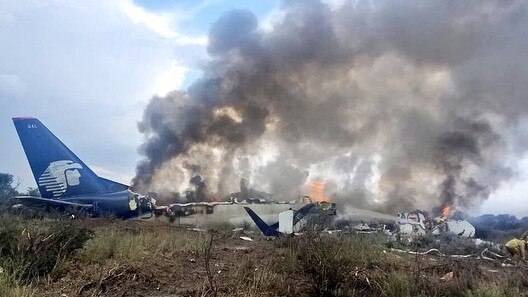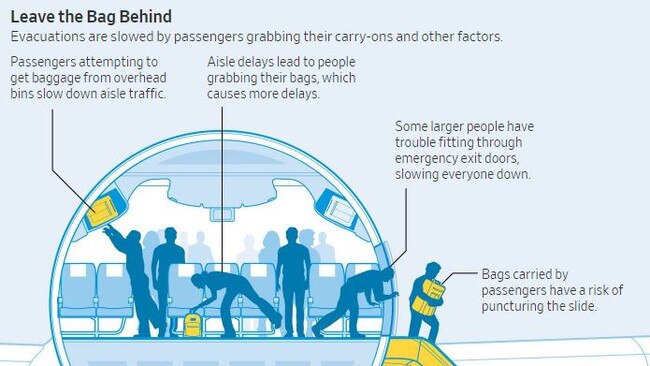The dangerous mistake passengers keep making
It’s one of the most significant threats to passenger safety, yet few are addressing the problem.

It’s one of the most significant threats to passenger safety, yet few are addressing the problem.
Time after time, aeroplane passengers fleeing a burning or crippled aeroplane take their carry-on bags with them. Toting luggage slows escapes, could block exits and risks puncturing emergency slides. This kind of behaviour could get someone killed.
Crashes and evacuations have gotten rarer as airline safety records have improved worldwide. But engine failures and fires still happen. Planes still run off the end of runways or land short, creating emergencies for ill-prepared passengers. As the Aeromexico crash in Durango, Mexico, on Tuesday showed, even violent, fiery crashes are highly survivable because of safety improvements in aeroplane cabins. Everyone survived that accident.

But safety investigators are voicing growing concern over a big issue. The Transportation Safety Board of Canada concluded in July that an evacuation from a WestJet 737 in Toronto in January was slowed by passengers retrieving their carry-on bags before fleeing a plane that was on fire. The London-based Royal Aeronautical Society published a study in April of 30 evacuations with a recommendation that regulators study the feasibility of locking overhead bins before takeoff and before landing.
“Until we have a situation where people do get hurt, or killed, [or] can’t get out, then the authorities probably just say, ‘Well, everything’s going fine,’ ” says Nick Butcher, one of the authors of the RAS study and a cabin-safety veteran who spent more than 30 years at the United Kingdom’s Civil Aviation Authority.
The carry-on baggage problem isn’t new, although cellphone videos from accidents have shed more light on it. Mr Butcher thinks it may have worsened because of the increasing value of the items we carry in bags — electronics, medications and other “necessities.” And fees for checked baggage have prompted passengers to carry more stuff on board.
One other serious threat to speedy evacuations these days: airlines splitting families up when assigning seats, the RAS suggests. If children aren’t seated in the same row, parents are going to go find them before evacuating, possibly disrupting the flow.
In January, the National Transportation Safety Board concluded that the evacuation from American Airlines Flight 383, a 767 that had an uncontained engine failure and fire as it was rolling for takeoff in Chicago in 2016, was impeded by passengers grabbing luggage. The NTSB recommended that the Federal Aviation Administration study the hazards of carrying luggage during evacuations.
The FAA says it will review and consider the NTSB’s recommendation by April 2019.
Asked about locking bins, the FAA issued a statement citing several disadvantages, including adding a step to crew procedures, unintended consequences such as difficulty fighting a fire inside a locked bin and the cost of installing locks and training crew.
The FAA, which has regulations with very specific requirements for the language of safety briefings, like how to unbuckle seat belts, has opted to make carry-on baggage warnings optional.
Airlines are encouraged but not required to include instructions to leave carry-on bags behind in an evacuation in verbal or video preflight safety briefings. (Only some do.)
FAA regulations require them to mention this issue on safety briefing cards placed in seat-back pockets. But the message is often easy to miss for the few who bother looking at the cards. Those cards typically have a small picture of a passenger with a carry-on bag and a red line through it.
The agency says it does encourage airlines to include instructions to leave bags behind in the orders flight attendants yell to passengers in an actual emergency. Asked if this should become required in light of recent incidents, the FAA issued a statement saying it was “up to individual airlines.”
And an FAA official noted in an interview that while evacuations may be slowed by some factors like baggage, they actually are assisted by more protections in place today to improve safety, such as materials in aircraft that burn slower. “The recent safety record is pretty good. Most evacuations are successful, even if some behaviour is not ideal,” the official says.
Of course, travellers routinely ignore safety briefings. When US Airways Flight 1549 splashed down on the Hudson River in 2009, few passengers thought to grab life vests.
In an emergency, passengers still spend time in the aisle waiting to get off the plane — emergency exits are the limiting factor. So they have temptation and opportunity — while they wait, their carry-ons are in the bin right beside their head.
Canada’s safety board found that on Aug. 2, 2005, when an Air France wide-body A340 jet ran off the end of a runway in Toronto, the fuselage split into two pieces and erupted into flames four minutes later. Still, about 50% of the passengers retrieved cabin baggage as they escaped — even though “flight attendants repeatedly provided specific instructions to the contrary,” the TSB report noted.
The safety investigator recommended requiring that passenger safety briefings include clear direction to leave carry-ons during an evacuation. But Transport Canada, that country’s regulator similar to the FAA in the U.S., issued an advisory to airlines making it voluntary.
After the WestJet incident, the safety board sampled a small number of regularly scheduled flights on different airlines. None provided instructions about leaving carry-on bags behind. The WestJet flight didn’t include carry-on instructions in its safety briefing, but flight attendants repeatedly told passengers to leave bags behind during the evacuation.
Despite that, several retrieved bags. The safety board concluded that this delayed the evacuation, but didn’t specify by how much. There were other complications. In all, the evacuation of 169 passengers and six crew members on the flight from Cancún on Jan. 5 took three minutes and nine seconds from when the first emergency exit opened. In certification tests, it’s supposed to take 90 seconds.
A spokeswoman for Transport Canada says the agency is aware of the recent RAS recommendations but hasn’t yet studied the feasibility, benefits or challenges of its proposals.
The RAS study found most evacuations went very well, though many took place without a full passenger load. The Boeing 777-200 is certified for a full load of 440 passengers. When a British Airways 777-200 had an engine failure and fire erupted on one side in Las Vegas in 2015, there were only 283 seats on the plane and just 157 passengers on board.
Only two evacuation slides were available — had one been punctured by a roll-aboard bag thrown down it, or if there had been a full passenger load, “the situation could have been very different” Mr Butcher says.
The Wall Street Journal



